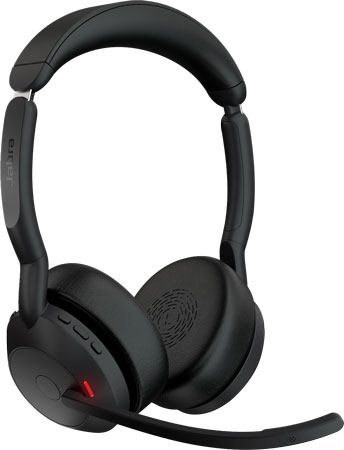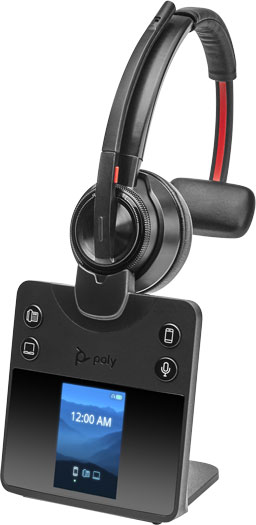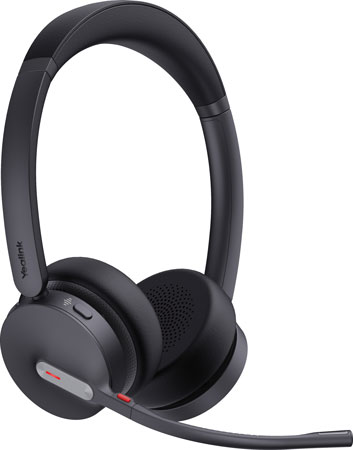When looking for a Wireless Headset for VoIP, you have two options: Bluetooth or DECT. These are the two wireless technologies used for business headsets.
In this blog, we introduce each technology and clearly explain the pros and cons of Bluetooth headsets vs DECT headsets. To finish, we touch on hybrid Bluetooth/DECT headsets.
Wireless headsets are prized by workers because, unlike wired headsets, they don’t tie you to your desk. At the same time, you get the professional audio quality and hands-free convenience that make headsets valuable. Both Bluetooth headsets and DECT headsets offer these conveniences. But there are important reasons why people choose one or the other.
You can buy wireless headsets for VoIP phones, as well as wireless headsets for softphones from cloud phone services and unified communications platforms like Microsoft Teams, 8x8, Webex, Dialpad, RingCentral, and Zoom.
Let’s get into it!

Bluetooth Headsets for VoIP
Bluetooth Headsets are wireless headsets that use Bluetooth to connect with devices. Bluetooth is a well-established standard for short-distance wireless connectivity… Who are we kidding? We all know what Bluetooth is.
What you might not know is that the name Bluetooth comes from a 10th-century Danish king. (For real!)
Also, what we call “Bluetooth” is actually a complex set of standards that has gone through many revisions since it was first established in the late 1990’s. That means devices use many different versions of Bluetooth. Most of the time you can find out what version of Bluetooth your headset uses by looking at its datasheet.
The newest Bluetooth version as of the publishing of this blog (October 2024) is Bluetooth 6.0, although the latest smartphones from Apple, Samsung, and Google only use Bluetooth 5.3. As of today, you can find headsets like Yealink WH64 Hybrid Mono UC that use Bluetooth 5.2.
All versions of Bluetooth are backwards compatible and basically the newer the version, the more features it offers — features like increased pairing capability or increased wireless range.
On top of the different versions, there are a host of protocols and profiles within the Bluetooth standard that affect your experience. For example, you might come across the term A2DP (Advanced Audio Distribution Profile). This profile uses a Bluetooth protocol that allows a device to stream audio using the channel intended for video. Because video needs more bandwidth than audio, the video channel is larger by default. So, by using the video channel for audio, it can use more bandwidth for the audio stream. The result? Better sound quality — or at least the potential for better sound quality. Most (if not all) headsets today support the A2DP profile.
This blog isn’t the place to go through every Bluetooth version, protocol, and profile — there are a lot of them. Instead, we’re going to cover why you’d want to use a Bluetooth headset for VoIP at all.
What are the advantages of Bluetooth headsets for VoIP?
The primary advantage of using a Bluetooth headset for VoIP is interoperability. There are so many Bluetooth devices — smartphones, tablets, and so on — that are so important to business. Why shouldn’t you be able to use your office headset with your iPhone?
A Bluetooth headset offers all the convenience of a wireless headset and can be used directly with a very broad range of devices, making it a versatile solution for business communications. DECT headsets cannot connect directly with your devices: they require a base station or a dongle.
In some cases, however, you’ll need to use a dongle even for Bluetooth. To connect a Bluetooth headset with a computer, you’ll need a Bluetooth adapter. This will be a USB dongle that you plug into a USB port on the computer. In most cases, there will be options for both USB-A and USB-C ports. After you plug in the dongle, the headset will be selectable as a USB audio peripheral — simple.
Most VoIP softphone apps support USB peripherals. So that’s good! Know, however, that while you’ll be able to use the headset, you may not get full call controls, as covered in our recent blog, “An Introduction to HID-Compatible Headsets for VoIP.”
Many VoIP phones also require a Bluetooth headset dongle, although an increasing number of VoIP phones have a Bluetooth radio built in. If the phone requires a dongle, it’s the same experience as a computer. If not, then it’s the same experience as pairing a Bluetooth headset with your mobile phone. Make sure to look at the VoIP phone’s datasheet to see if it has native Bluetooth support or a USB port that supports a Bluetooth dongle for headsets.
Another big advantage of Bluetooth is familiarity. Pretty much everyone uses Bluetooth in our daily lives, whether that’s for a remote control, speaker, headphones, keyboard, mouse, car, and so on. A Bluetooth headset works in the same way as these everyday devices, so it has a super easy learning curve. Nice!
Finally, a word of advice. When shopping for a Bluetooth headset, look for three things in the datasheet: paired devices, simultaneous connections, and wireless range.
- Paired devices. A Bluetooth device needs to pair with a device for the headset to connect to it. Think of pairing as a creating a trusted network link between two devices. A Bluetooth headset remembers the trusted credentials of a certain number of devices: that’s the paired devices number. If your headset can remember more paired devices, then you don’t need to put it into Bluetooth pairing mode as often — so it’s more convenient. Many headsets now can remember 8 paired devices.
- Simultaneous connections. In the world of Bluetooth, a connection means an active transmission between paired devices. Many headsets now support 2 simultaneous connections — again, more convenient.
- Wireless range. How far away can your Bluetooth headset be from a connected device before the signal drops out? Most companies give a range that’s based on optimal conditions: line of sight with no obstructions. But real-world obstacles like walls can significantly impact your wireless range. Still, the bigger the number, the better when it comes to wireless range. You can now find wireless ranges around 150 feet line of sight.
A Bluetooth headset for VoIP is an excellent choice. But many people choose a DECT headset for VoIP. Why?

DECT Headsets for VoIP
DECT Headsets use the DECT protocol for wireless connectivity. DECT is a well-established standard that’s been around since the 1980’s. If you remember wireless telephones at home, they probably used DECT — although there have been significant advancements made over the years, particularly in the realm of security. We cover that in a bit.
What are the advantages of DECT headsets for VoIP?
DECT has two big advantages over Bluetooth: improving wireless range and lessening spectrum density.
The first advantage is easy to explain: DECT has a more extended wireless range than Bluetooth. For example, Poly Savi 8445 Office UC — which weighs only 21 grams (that’s about 4 nickels) — still has a maximum wireless range of 590 feet, which is way beyond what any Bluetooth headset can do.
Now, as with Bluetooth, obstructions can take a big toll on the real-life wireless range of a DECT headset, so you won’t actually be able to use the headset two football fields away from its base, but it’ll still have a much more extended range than a comparable Bluetooth headset used in the same conditions.
The second advantage takes a few more words to explain: DECT headsets serve to reduce wireless spectrum density in the office. What does that mean?
Wireless devices use specific sections of the wireless spectrum as dictated by regulations and industry standards. In offices today, there is an ever-increasing number of wireless devices — not just phones and laptops, but smart sensors, security cameras, light bulbs, and so on. Most of these wireless devices use either Bluetooth or Wi-Fi.
If you have a whole bunch of devices all competing for the same slice of the Bluetooth spectrum, this can lead to crowding — there are too many mouths to feed. And crowding can lead to devices having worse signals as they compete with every other device in the area. This problem is particularly acute in smaller spaces like offices.
DECT uses a different slice of the wireless spectrum than Bluetooth or Wi-Fi. And there are in a typical office far fewer DECT devices than Bluetooth or Wi-Fi devices.
By using a DECT headset, you’re removing a wireless device from competition over the Bluetooth spectrum, thus reducing spectrum density. The result? Your Bluetooth devices have more space, so they’ll have a better signal. And you’ll be using what will likely be a less competitive part of the spectrum, so your DECT signal will be good, too. Win-win.
Something to know: There are a couple terms you’ll come across when shopping for a DECT headset for VoIP: DECT 6.0 and Secure DECT.
DECT 6.0 is a marketing term (originally by Siemens) for DECT as implemented in North America, which is different from how it’s implemented in the rest of the world. Basically, in North America, we use a different and smaller portion of the wireless spectrum. The “6.0” part of the name doesn’t refer to anything: it’s not the sixth generation of DECT and it doesn’t use that part of the wireless spectrum. So all you need to know is this: DECT 6.0 is the standard North American implementation of DECT.
Secure DECT is more important to know about.
Communications security is of paramount importance today. Because DECT is an older standard in tech terms, over time serious holes in its security were revealed. So the industry has significantly improved encryption, authentication, and more.
The DECT Forum provides a DECT Security certification program to provide an objective guarantee that a manufacturer has implemented DECT with a high level of encryption. Manufacturers will refer often to this as Secure DECT or something similar. If you see Security DECT Step C, just know that Step C is the highest level of security that the DECT Forum’s certification program currently specifies.
Some manufacturers go beyond the DECT Forum’s specifications. For example, Jabra Engage 55 meets the FIPS 140-2 standard, which is a US government security standard. The headset uses 256-bit encryption to protect your calls.
To sum up: if communications security is important to you — and it should be — look for DECT Security certified headsets.

Hybrid Bluetooth/DECT Headsets for VoIP
Do you have to choose either Bluetooth or DECT? Until recently, the answer was pretty much: Yes, it’s one or the other.
However, there are now headsets that offer dual connectivity.
There are two ways that headset manufacturers have solved the problem of dual Bluetooth and DECT connectivity:
- The headset itself supports both DECT and Bluetooth.
- The headset supports DECT. It communicates via DECT with a base. The base connects to devices like a computer or phone via cables to enable the headset to use DECT with these devices. The base also connects to devices like a smartphone or tablet via Bluetooth to enable the headset to use Bluetooth (via DECT) with these devices. In other words, it’s a DECT headset with a base that supports both DECT and Bluetooth.
The Yealink WH64 Hybrid Series is an example of the first type of hybrid wireless headsets for VoIP. Yealink WH64 Hybrid Mono Teams, a wireless headset with native integration with Microsoft Teams, uses Hybrid Core technology: it has both a DECT radio and a Bluetooth radio built in. The headset comes with a DECT dongle that you can plug into a computer or VoIP phone, so you can use the headset via DECT without a base station — convenient. Or you can put it into Bluetooth mode and use it like any other Bluetooth headset — doubly convenient.
The Poly Savi 8400 Office Series is an example of the second type of hybrid DECT plus Bluetooth headsets for VoIP. The headset itself connects wirelessly with its base station via DECT. The base connects via cables to a phone and computer and via Bluetooth to a smartphone. All the communications flows through the base to/from the headset, so you get triple connectivity — phone, computer, mobile device. Switch between which device you’re using by pressing the appropriate button on the base station. In this way, a headset like Poly Savi 8420 Office is a hybrid DECT/Bluetooth wireless headset for VoIP.

